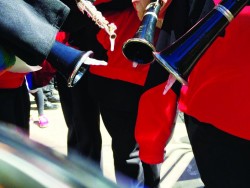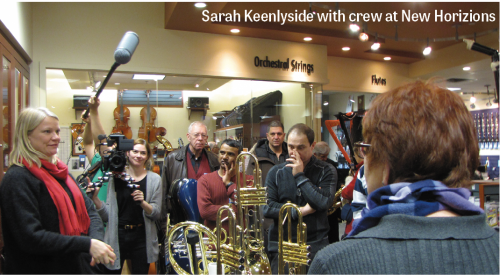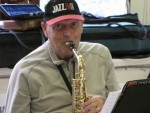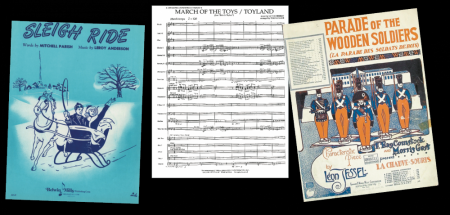What Do You Call Two Didgeridoos?
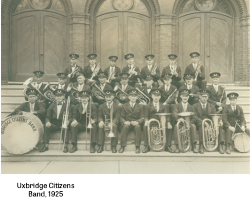 For the past two issues I have speculated on just when spring might arrive. It is now mid-April and, at time of writing, there is lots of that white stuff on the ground once again, so rather than jinxing things once again, let’s just say my seasonal optimism is being fuelled by the information arriving from readers. One such announcement is the annual rebirth of the Uxbridge Community Concert Band for its 23rd season. Unlike most town bands, this group only gets together every summer starting in late May and ceases operation after their final summer concert in late August. That was not always the way in the town of Uxbridge, as I shall explain.
For the past two issues I have speculated on just when spring might arrive. It is now mid-April and, at time of writing, there is lots of that white stuff on the ground once again, so rather than jinxing things once again, let’s just say my seasonal optimism is being fuelled by the information arriving from readers. One such announcement is the annual rebirth of the Uxbridge Community Concert Band for its 23rd season. Unlike most town bands, this group only gets together every summer starting in late May and ceases operation after their final summer concert in late August. That was not always the way in the town of Uxbridge, as I shall explain.
Today Uxbridge is noted for its broad spectrum of arts activities. From such events as Art in the Park, the Celebration of the Arts and concerts by three choirs to a constant stream of productions of plays and musicals in the town’s 100-plus-year-old music hall, there is no shortage of arts activities. For many years the town had a well-organized town band, but that disappeared. I am deeply indebted to Mr. Walter Taylor, former Town Clerk of Uxbridge for supplying the photograph here. Taken in 1925, it shows the Uxbridge Citizens Band in uniform on the steps of one of the local churches. It is particularly interesting because it shows a band in the very era when there was a gradual transition of many town bands from all brass band to concert band.
In the early part of the 19th century throughout Britain and much of Western Europe, brass bands began to be formed. While many of these were town bands, many were sponsored by employers as a form of recreation for employees. These bands adopted the same instrumentation as the Salvation Army bands which began to appear about the same time. Brass instruments were particularly suitable for outdoor performance since their sound could project well out of doors and they were not prone to damage should a rainstorm interrupt a performance. There was another great advantage for instruction. By transposing various parts into appropriate keys it was feasible to conduct group instruction on the various instruments of the band. When I joined my first boys band the instruction was in a group. From cornet to tuba the spectrum of instruments, with the exception of the trombone, all learned the same fingering.
This 1925 photo shows a band in transition. The E-Flat horns and B-Flat baritones are still there, but the cornets are dwindling. The back row has only two cornets, as is common in a brass band, but the rest of the back row has trumpets. As for woodwinds, three clarinets have managed to sneak in, an early harbinger of the modern concert band’s woodwind section with lots of saxophones, clarinets, flutes and perhaps an oboe and a bassoon. It was certainly too early for French horns; they hadn’t made it yet.
I wonder what happened to that particular Uxbridge band? It was probably the victim of the great depression. There are some remnants of that band’s music library in the town’s museum; I can tell you, the titles of some of the works listed would no longer be “politically correct.”
On the subject of correctness, when speaking about the smallest of the brass instruments, many people mispronounce the word “cornet.” All too often one hears the word pronounced with the accent on the second “net” syllable rather than on the first “cor” syllable. That pronunciation is reserved for the “cornett,” a very different instrument. The cornet is a brass instrument similar to the trumpet, whereas the cornett is an instrument made of wood or ivory. It is a long tapered instrument with finger holes, similar in appearance to a recorder, with a cup mouthpiece similar to that of a trumpet. It was commonly used in orchestras of the 16th and 17th centuries. Its much bigger brother (up to seven feet in length in an S shape) was the serpent which was still in use in bands in the 19th century. Many years ago I had the pleasure of playing briefly on both such instruments. Anyone interested in seeing a cornett may view one in the splendid display case in the entrance to Koerner Hall in Toronto.
Recent Happenings: Now for a bit about what has been happening about town. Last year at the annual small ensemble concert of the band of HMCS York at the Naval Club of Toronto we had a photo of trombonist Leading Seaman James Chilton performing on his didgeridoo. At the time he mentioned that he was playing on a factory-made instrument, but was hoping to own a genuine native Australian instrument made from the trunk of a eucalyptus tree, the core of which is hollowed out by termites. While he was back this year with his trombones, including a soprano trombone (sometimes referred to as slide trumpet), he was there with didgeridoos in hand. His wish has been realized. The factory-made instrument was there along with his prized original native instrument. With his wife Denise at his side, playing the factory instrument, we were treated to a new experience. This time we heard a didgeridooet!
Speaking of the HMCS York Band, conductor Lieutenant Jack t’Mannetje is hoping to gradually build up a history of the bands of HMCS York since WWII. If any readers have recollections of these bands over the past 70 years, please let us hear from you.
While it was not in the community band sphere, I would be remiss if I didn’t mention a recent “Spring Fling Concert” celebrating 25 years of teaching by Jane Plewman. Jane teaches string instruments at her home at Chalk Lake northeast of Toronto. The delightful evening featured performances by players at all levels, from beginner to advanced, performing in a variety of ensembles. What was inspiring was to see toddlers performing with confidence alongside white-haired grandparents; the joy of making music together. From basic Suzuki melodies to works of Handel, Bach, Boccherini and Telemann, the enthusiasm was always there.
On the Horizon: On May 3 the York University Community Band Festival will take place all afternoon and evening. Each year four bands are invited to participate. This year’s contingent might well be described as the North Yonge Street group. The bands are from Thornhill, Richmond Hill, Aurora and Newmarket. During the afternoon there will be a massed band session followed by woodwind and brass tuning sessions and a percussion clinic. In the evening the bands will perform individually for adjudication. The following day, on May 4, I will have the pleasure of attending a concert titled “Once Upon A Tune,” the final event of the East York Concert Band’s 61st season. (I first met and wrote about their current conductor, Joseph Resendes, a few years ago when, as a graduate student in music, he assumed direction of the then new Milton Concert Band.)
Usually the Wychwood Clarinet Choir can be counted on to have an unusual treat in their offerings. This year is no exception. Their concert on May 25 at 3:30, titled “Spring Vibrations,” will feature guest vibraphonist Arnold Faber performing an original work which he wrote for the choir. The program will also include the first public performance of Canadian Folk Song Suite written by the choir’s assistant director Roy Greaves.
On May 30 the various New Horizons bands of Toronto will present their final concert of the season at St. Michael’s College School at 7:30. There will be a film crew there to complete the filming for the documentary planned for broadcast on TVO this coming fall. As for the New Horizons Bands in Peterborough, if the snow has finally stopped for a while, a visit soon with the prospect of clear roads seems imminent.
Down the road: We have recently learned that a new concert band is in the works in Toronto’s west end this fall. So far there is no information on location, rehearsal days, etc.
Resa’s Pieces groups all have concerts scheduled for dates in June. We have received an interesting account of how these groups came into being, but it is too long for inclusion in this issue. We hope to have it posted on TheWholenote website soon.
Elsewhere in this issue there is an interesting classified advertisement by Emily Benedictis for the sale of many scores of band music owned by her late father, Mariano De Benedictis. Unfortunately this information arrived too late for me to find out more about the music and life of a Hamilton man who by all accounts had a rich community musical life. More next time perhaps?
Definition Department: This month’s lesser known musical term is: Cantabile: To achieve a complaining sound, as if you have a sour stomach.
We invite submissions from readers. Let’s hear your daffynitions.
Jack MacQuarrie plays several brass instruments and has performed in many community ensembles. He can be contacted at bandstand@thewholenote.com


